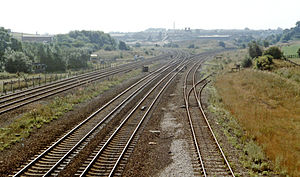Clay Cross | |
|---|---|
 Site of the station looking south towards the Erewash on the left and the Derby line on the right. | |
| General information | |
| Location | Tupton, North East Derbyshire England |
| Grid reference | SK401651 |
| Platforms | 4 |
| Other information | |
| Status | Disused |
| History | |
| Original company | North Midland Railway |
| Pre-grouping | Midland Railway |
| Post-grouping | LMS British Railways |
| Key dates | |
| 11 May 1840[1] | Opened |
| 1967 | Closed |
Clay Cross railway station was a railway station built by the North Midland Railway in 1840. It served the town of Clay Cross in Derbyshire, England.
It was originally planned to have been built within the Clay Cross Tunnel, however it was clear that it would be impossible to ventilate it effectively, so instead it was built at the northern entrance - nearer to Tupton.
The original station was the usual Francis Thompson Italianate design.
The station was the site of a fatal accident on 19 May 1851 which killed two people and injured sixteen others.[2] The locomotive of a passenger train which left Derby at 21:05 for Leeds suffered a broken pump-rod. The driver stopped near Clay Cross station to remove the broken part and the rear of his train was hit by a goods train and smashed into the last two carriages.[3] At an inquest, the jury reached a verdict of manslaughter against the driver of the goods train, Samuel Stretton, but also condemned the railway company practice of allowing a goods train to follow a passenger train with a gap of only five minutes, the lack of a night signalman at Clay Cross, and the regular practice of allowing trains to stop at stations which were not listed in the timetable.[4]
The Erewash Valley line opened on 1 May 1862 and had its northernmost connection at Clay Cross.[5]
In 1877 the Midland Railway went out to tender for the rebuilding of the station.[6] The alterations for the additional traffic resulting from the Erewash Valley Line were completed by January 1878.[7] A link line from Clay Cross South Junction to Clay Cross North Junction comprised a double line each for goods and passenger traffic from the Sheffield junction at Tapton, north of Chesterfield, to the junction of the Erewash Valley branch south of Clay Cross. The station was rebuilt in the Midland Railway styles and the platforms were improved. An additional platform was added for the Erewash Valley trains. Three large platforms were opened, one outside the outer lines and a large on in the centre, connected by covered staircases and bridges so as to enable passengers to cross the line in safety.
The station closed in 1967 and was subsequently demolished. No trace remains of the station, but the goods shed is still in place on the south side of the bridge.
North of Clay Cross, there developed very busy coal sidings, particularly those serving the Avenue Coal Carbonisation Plant. A locomotive shed was built at Hasland in 1861 with at one time as many as sixty engines. In the 1960s it supported sixteen Garratt 2-6-0+0-6-2 locomotives used for the coal traffic from Yorkshire.
The next station northwards was at Chesterfield.
- ^ "Opening of the North Midland Railway". Derbyshire Courier. England. 16 May 1840. Retrieved 12 February 2021 – via British Newspaper Archive.
- ^ "Accident at Clay Cross on 19th May 1851". Railways Archive. Retrieved 12 February 2021.
- ^ "Appaling Railway Accident at Clay-Cross, Derbyshire". Nottinghamshire Guardian. England. 22 May 1851. Retrieved 12 February 2021 – via British Newspaper Archive.
- ^ "The fatal accident at Clay Cross on the Midland Railway". Yorkshire Gazette. England. 31 May 1851. Retrieved 12 February 2021 – via British Newspaper Archive.
- ^ "The Erewash Valley and the Midland Railway". Nottinghamshire Guardian. England. 9 May 1862. Retrieved 12 February 2021 – via British Newspaper Archive.
- ^ "Midland Railway". Derbyshire Times and Chesterfield Herald. England. 24 March 1877. Retrieved 12 February 2021 – via British Newspaper Archive.
- ^ "Additional Railway Accommodation at Clay Cross". Derbyshire Courier. England. 5 January 1878. Retrieved 12 February 2021 – via British Newspaper Archive.